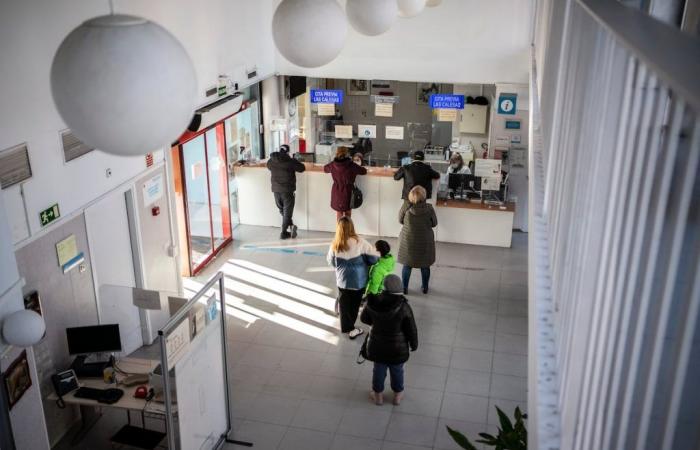A doctor pays attention to the patient while an artificial intelligence program transcribes what he says, translating it in clinical terms and noting it in your file. The AI itself reviews the more than 20 years of history on your file, warns the doctor of relevant history for the case that he had missed because it was too old, and requests the necessary appointments from the specialists, which are validated by the doctor. doctor with one click. The scene is technically possible today, and could become a powerful ally to alleviate the traffic jam in Primary Care that Spain has suffered since the pandemic. But it is still far from being a reality in health centers.
Being more attentive to typing than looking at the patient’s face, not having enough time to investigate their problems, the endless bureaucratic procedures that take away dedication from the patients are some of the recurring complaints of Family and Community Medicine specialists who They could be solved almost at a stroke with technologies that are already on the market. They are relatively simple tasks for artificial intelligence, with little margin for error; day-to-day management that adds up to an immense potential that, according to all experts, will change the way we do medicine in the coming years.
This has been one of the major topics of debate at the 30th Congress of the Spanish Society of General and Family Physicians (SEMG), which is being held these days in A Coruña and to which EL PAÍS has attended at the invitation of the organization. Faced with these almost infinite possibilities that it offers, the meeting also analyzed the great barriers that leave it unknown when they can begin to be used in daily practice: the security of clinical data, some ethical implications, and the difficulty to change the systems and processes in a mammoth administration such as healthcare. As an example, the interconnection of medical records has not yet been completed so that a doctor can see the records of any patient he or she treats, regardless of where they come from (and Spain is one of the most advanced countries in this field).
The company Recog Analytics has already created a software that can do what was stated at the beginning of this report. Alberto Castaño, one of its co-founders, explains that although it is not yet used on a daily basis, it is already in pilot projects by a large number of private insurers, and is about to be tested as an experiment in Catalan public healthcare. “These systems cover a need that doctors always convey and, when they try it, they are happy with their results. I think that the pressure they put on the administration will lead to it being implemented faster than other technologies,” he explains.
The idea is that your program (or another artificial intelligence capable of similar tasks) is integrated into the systems of health centers and hospitals. Castaño lists what this technology is already capable of doing: “It transcribes the consultation, automatically writes clinical notes as if it were a doctor (if the patient says his head hurts a lot, he writes down ‘intense headache’, for example). He makes requests for automatic appointments and follow-up, if the professional says that he is going to ask you for an x-ray, a small window appears to do so and he can click ‘ok’.
So far, the most basic. “We are working on a summary of the medical history so that the doctor can have a context before the consultation, including a report for the patient that tells him in simple language what he has, what he should take… Also notices to the health worker in case Things happen to them, such as if the patient has said they are allergic to something and has been prescribed it, or alerts that say things like: ‘You forgot to ask if they have a family history of heart attacks’, which warn of interactions between medications they are taking. taking, or that you have been consuming it for longer than recommended,” continues Castaño.
Carlos Durán, coordinator of Digital Health at SEMG, considers that these technologies can become a kind of “co-pilot” that assists the doctor during the consultation: “Far from dehumanizing care, as some think can happen with artificial intelligence , it will become more human and closer, because it will free us from the technical and bureaucratic processes in which we spend most of our time.”
They are not immediate solutions; but there is hope in the midst of a context of controversy due to the lack of primary doctors and in the face of a complicated summer in health centers due to lack of personnel, as the councilors of the autonomous communities themselves, in charge of managing, have been warning for weeks. healthcare.
The constraints that the system is experiencing not only impact patient care, but also the training of new doctors. Cristina Santomé, a third-year resident at a health center in Lugo, explains that with tutors increasingly overwhelmed by the workload, AI could also be a learning tool. She gives an example: “Our tutors present us with simulated cases so that we can make decisions, and they correct us if we make mistakes. That could perfectly be done with artificial intelligence, but today nothing like that exists.”
Something in which AI is already beginning to be used (although it has a long way to go) is in management. Many processes can be optimized and resources made better use of with systems that analyze the supply and demand of care. Jano, a virtual assistant, was already an important piece in managing covid vaccinations in Cantabria.
Maria Isabel Priede, family doctor and director of Social and Health Humanization in that community, explains how a patient in her quota, whom she had never seen, was admitted after a suicide attempt. “She had gone to the emergency room many times, but I didn’t know it, I didn’t even know her,” she says. A pilot project is working to identify risk factors in patients so that they can notify the doctor directly and have the doctor proactively schedule an appointment for their consultation.
Another European pilot project analyzes electrocardiograms to detect early signs of heart failure in Primary Care; It provides doctors with a score on the disease and allows them to improve their decisions to refer the patient to the cardiologist if necessary, or not to refer the patient to the cardiologist if it is not necessary. This joins what is probably the field in medicine that will most and soon revolutionize AI: the interpretation of diagnostic images.
The risks of AI
“The analysis that AI can do of any image from any analytical or image study is superior, for sure, to what the human eye can see,” assumes José Rodríguez Sendín, member of the SEMG Bioethics group. This doctor, however, has not attended the congress to praise the improvements of AI (which he recognizes), but to warn of its dangers, which also have them. He warns of the possibility of “breach of clinical data”, as AI can access “highly sensitive patient” information. “A failure to protect this information can lead to the exposure of medical records, diagnoses and genetic data, which not only affects the individual but also their offspring. Loss of confidentiality can result in discrimination by employers and insurers, who could use this information to make decisions that are harmful to the patient,” he relates.
Another important challenge, in Sendín’s opinion, is the lack of transparency in the development and application of artificial intelligence. “Many times, the objectives and methods of developers are not clear, which generates distrust. The complexity of these systems and lack of understanding by end users can lead to a lack of responsibility and accountability. Without a clear and proven methodology, the promises of AI may not materialize, or worse, cause significant harm,” he adds.
Europe is already preparing for these scenarios. The European Health Data Space (EHDS) Regulation aims to guarantee individual access, interoperability, data protection and secondary use for research and innovation. But it also warns of risks, such as the possible perpetuation of bias, lack of digital literacy and patient safety issues.






